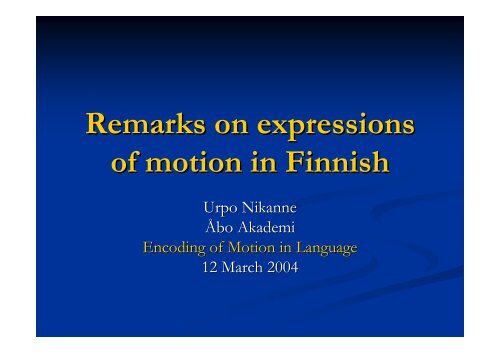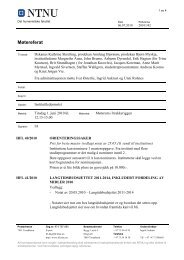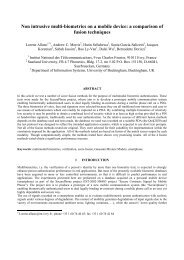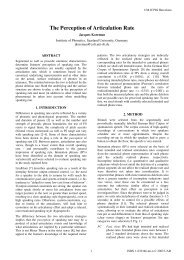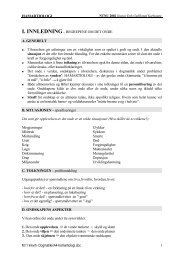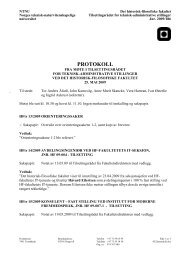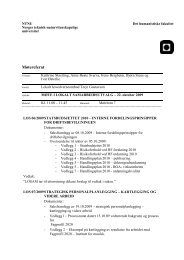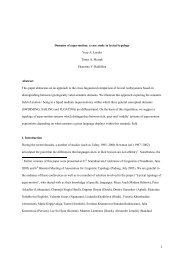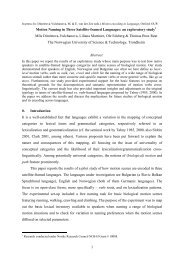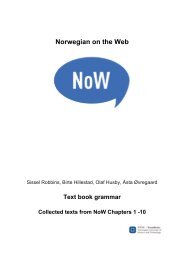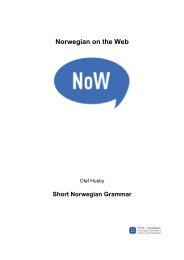Remarks on expressions of motion in Finnish
Remarks on expressions of motion in Finnish
Remarks on expressions of motion in Finnish
You also want an ePaper? Increase the reach of your titles
YUMPU automatically turns print PDFs into web optimized ePapers that Google loves.
<str<strong>on</strong>g>Remarks</str<strong>on</strong>g> <strong>on</strong> expressi<strong>on</strong>s<br />
<strong>of</strong> moti<strong>on</strong> <strong>in</strong> F<strong>in</strong>nish<br />
Urpo Nikanne<br />
Åbo Akademi<br />
Encod<strong>in</strong>g <strong>of</strong> Moti<strong>on</strong> <strong>in</strong> Language<br />
12 March 2004
C<strong>on</strong>tents <strong>of</strong> the talk<br />
What can we say about c<strong>on</strong>ceptualizati<strong>on</strong> <strong>of</strong><br />
moti<strong>on</strong> by study<strong>in</strong>g (the F<strong>in</strong>nish) language?<br />
Some examples <strong>of</strong><br />
• Moti<strong>on</strong> verbs<br />
• Locative cases & postpositi<strong>on</strong>s<br />
• C<strong>on</strong>structi<strong>on</strong>s
PART I<br />
REMARKS ON<br />
MOTION VERBS
Examples <strong>of</strong> typical moti<strong>on</strong><br />
verbs: jump<strong>in</strong>g <strong>in</strong> F<strong>in</strong>nish<br />
F<strong>in</strong>nish has two sets <strong>of</strong> verbs for ’jump’: momentanic (<strong>on</strong>e jump)<br />
and frequentative (several jumps)<br />
hypätä, pompata (<strong>on</strong>ce)<br />
hyppiä, pomppia (several times)<br />
Vertical moti<strong>on</strong> refers to moti<strong>on</strong> al<strong>on</strong>g the vertical axis.<br />
Horiz<strong>on</strong>tal and vertical moti<strong>on</strong> may be comb<strong>in</strong>ed. The actual<br />
moti<strong>on</strong> is not follow<strong>in</strong>g the vertical axis. The vertical verbs can be<br />
used.<br />
Pomppaa1<br />
Pomppaa2<br />
Pomppii1<br />
pomppii2
Some critical features <strong>of</strong> the moti<strong>on</strong><br />
verbs<br />
• Even though the moti<strong>on</strong> encoded <strong>in</strong> the verbs is<br />
schematic, , the verbs are sensitive to certa<strong>in</strong><br />
spatial features, , for <strong>in</strong>stance, , the shape <strong>of</strong> the<br />
path, speed, , etc.<br />
• Which verb would you use for this moti<strong>on</strong>?<br />
pomppaako
The gra<strong>in</strong> levels <strong>of</strong> moti<strong>on</strong><br />
• Accord<strong>in</strong>g to van der Zee and Nikanne (<strong>in</strong> progress),<br />
there are three gra<strong>in</strong> levels <strong>of</strong> encod<strong>in</strong>g the path the<br />
moti<strong>on</strong> takes place:<br />
1. neutral (mennä ’go,’ siirtyä ’change<br />
place’ )<br />
2. global (kaartaa<br />
’go<br />
al<strong>on</strong>g a curved path’)<br />
3. local (mutkitella<br />
’make<br />
curves the path,’<br />
hyppiä ’jump<br />
(freq.)’)<br />
• In additi<strong>on</strong> to these three levels, it is possible to use a<br />
manner <strong>of</strong> moti<strong>on</strong> verb (horjua, heilua) to <strong>in</strong>dicate a<br />
neutral path.<br />
F1
Lysbilde 6<br />
F1 FIN; 07.03.2004
Gra<strong>in</strong> level 0: neutral<br />
mennä A:sta B:hen ’go<br />
from A to B’ B<br />
FOCUS ON THE GLOBAL CURVE<br />
B<br />
A
Gra<strong>in</strong> level 1: global path<br />
• kaartaa A:sta B:hen ’curve<br />
<strong>on</strong> from A to B’ B<br />
FOCUS ON THE GLOBAL CURVE<br />
B<br />
A
Gra<strong>in</strong> level 2: local<br />
mutkitella A:sta B:hen<br />
’go<br />
from A to B mak<strong>in</strong>g small curves <strong>on</strong> the way’<br />
FOCUS IS ON THE LOCAL CURVES<br />
B<br />
A
Manner <strong>of</strong> moti<strong>on</strong><br />
• Manner <strong>of</strong> moti<strong>on</strong> verbs like heilua, horjua,<br />
vaappua etc. ’rock’ may me used with path<br />
expressi<strong>on</strong>s. . The result is a gra<strong>in</strong> level 0:<br />
SUBJ - V(MANNER OF MOTION) - PATH<br />
Mies horjuu töistt<br />
istä koti<strong>in</strong>.<br />
man rock-3SG<br />
work-ELA<br />
home-ILL.<br />
’The<br />
man is rock<strong>in</strong>g from work to home.’<br />
Pragmatic factors an image <strong>of</strong> a curved path.<br />
Not a necessary <strong>in</strong>terpretati<strong>on</strong>.
Some remarks <strong>on</strong> the gra<strong>in</strong> levels<br />
• There are not many verbs express<strong>in</strong>g gra<strong>in</strong> levels<br />
1 (global(<br />
global) ) and 2 (local(<br />
local).<br />
There are <strong>on</strong>ly a handful<br />
<strong>of</strong> verbs express<strong>in</strong>g the gra<strong>in</strong> level 0 (neutral(<br />
neutral).<br />
• The role <strong>of</strong> pragmatics with level 2: the local<br />
paths do not necessarily have to be encoded <strong>in</strong><br />
the verb.<br />
• But: what is the reas<strong>on</strong> the lack <strong>of</strong> verbs<br />
express<strong>in</strong>g gra<strong>in</strong> level 1?
Th<strong>in</strong>gs to be studied<br />
• Which spatial features can be encoded <strong>in</strong> the<br />
LSS (lexical(<br />
spatial structure) ) <strong>of</strong> the verb? Do<br />
languages differ from each other <strong>in</strong> this respect?<br />
• Are the three gra<strong>in</strong> levels <strong>of</strong> the shape <strong>of</strong> the<br />
path encod<strong>in</strong>g universal or are there other<br />
systems am<strong>on</strong>g the languages <strong>of</strong> the world?<br />
• Are there differences between languages when it<br />
comes to the number <strong>of</strong> verbs encod<strong>in</strong>g<br />
different gra<strong>in</strong> levels <strong>in</strong> their LSS?
PART II<br />
REMARKS ON<br />
POSTPOSITIONS
’beh<strong>in</strong>d’ and ’<strong>in</strong><br />
fr<strong>on</strong>t <strong>of</strong>’<br />
(Nikanne<br />
2003, see also Coventry & Frias 2001)<br />
• In F<strong>in</strong>nish, there are two sets <strong>of</strong> postpositi<strong>on</strong>s<br />
<strong>in</strong>dicat<strong>in</strong>g the relati<strong>on</strong>s ’beh<strong>in</strong>d’ and ’<strong>in</strong><br />
fr<strong>on</strong>t <strong>of</strong>’.<br />
(directed,, 1-dimensi<strong>on</strong>al)<br />
1<br />
neutral<br />
mov<strong>in</strong>g<br />
objects<br />
’beh<strong>in</strong>d’<br />
takana<br />
peräss<br />
ssä<br />
jäljessä<br />
’<strong>in</strong><br />
fr<strong>on</strong>t <strong>of</strong>’<br />
edessä<br />
edellä
’In<br />
fr<strong>on</strong>t <strong>of</strong>’ and ’beh<strong>in</strong>d’:<br />
illustrati<strong>on</strong>s<br />
Statiti<strong>on</strong>ary objectsneutral<br />
postpositi<strong>on</strong>s<br />
edessä ’<strong>in</strong>-fr<strong>on</strong>t-<strong>of</strong>’ , takana ’beh<strong>in</strong>d’ (if<br />
applicable).<br />
• No <strong>in</strong>tr<strong>in</strong>sic directi<strong>on</strong><br />
Intr<strong>in</strong>sic directi<strong>on</strong><br />
<strong>on</strong>ly deictic motivati<strong>on</strong><br />
motivati<strong>on</strong><br />
• Autot1 (<strong>in</strong>tr<strong>in</strong>sic<br />
d + moti<strong>on</strong>),<br />
Seuraaja (no <strong>in</strong>tr<strong>in</strong>sic d + moti<strong>on</strong>)<br />
• Moti<strong>on</strong> 1 dimensi<strong>on</strong>al directed path
F<strong>in</strong>nish & germanic languages<br />
• F<strong>in</strong>nish: obligatory expressi<strong>on</strong> <strong>of</strong> directi<strong>on</strong>.<br />
• Germanic: not always necessary with moti<strong>on</strong><br />
verbs.<br />
• Compare:<br />
• Autot1 (edellä, edessä) ’<strong>in</strong><br />
fr<strong>on</strong>t <strong>of</strong>’ + place<br />
• Autot2 (edelle, eteen) ’<strong>in</strong><br />
fr<strong>on</strong>t <strong>of</strong>’ + directi<strong>on</strong><br />
• Taakse, perää<br />
ään
Orientati<strong>on</strong>s and dimensi<strong>on</strong>s<br />
• Accord<strong>in</strong>g to Nikanne 2003, orientati<strong>on</strong>s and<br />
dimensi<strong>on</strong>s are related to each other.<br />
• In the study <strong>of</strong> F<strong>in</strong>nish postpositi<strong>on</strong>s, it turned out that<br />
the vertical c<strong>on</strong>cepts (ylä- ’up’, ala- ’down’) are always<br />
vertical.<br />
• Other c<strong>on</strong>cepts (ete- ’<strong>in</strong>-fr<strong>on</strong>t-<strong>of</strong>’, taka- ’beh<strong>in</strong>d’, sivu-<br />
’side’) are more related to directi<strong>on</strong>ality and dimensi<strong>on</strong>s<br />
than orientati<strong>on</strong>s.
Dimensi<strong>on</strong>s<br />
up<br />
back<br />
horiz<strong>on</strong>tal<br />
side<br />
side<br />
fr<strong>on</strong>t<br />
vertical<br />
down
Besides and beh<strong>in</strong>d<br />
• ’Side’ c<strong>on</strong>cepts (postpositi<strong>on</strong>s<br />
vierellä, vieressä<br />
’beside’)) and ’<strong>in</strong>-fr<strong>on</strong>t-<strong>of</strong>’/’beh<strong>in</strong>d’ (edessä,<br />
edellä ’<strong>in</strong>-fr<strong>on</strong>t-<strong>of</strong>’ takana, peräss<br />
ssä, jäljessä<br />
’beh<strong>in</strong>d’) c<strong>on</strong>cepts are not necessarily<br />
horiz<strong>on</strong>tal:<br />
• Hyönteiset
Illustrati<strong>on</strong> <strong>of</strong> vertical and<br />
”horiz<strong>on</strong>tal” c<strong>on</strong>cepts<br />
• The vertical postpositi<strong>on</strong>s (’above,’ ’below’)<br />
always refer to a vertical dimenti<strong>on</strong>.<br />
• Vertikaali1<br />
• The vertical relati<strong>on</strong> between the objects: different<br />
postpositi<strong>on</strong>s <strong>in</strong> F<strong>in</strong>nish – yläpuolella,<br />
päällä, yllä(?),<br />
’above’, alapuolella, alla.<br />
• Vertikaali2<br />
• The green fly: always alapuolella ’below’
Dimensi<strong>on</strong>s and orientati<strong>on</strong>s<br />
(Nikanne<br />
2003)<br />
3D<br />
vertical 2D<br />
+ - perpendicular 1D<br />
ylä-<br />
ala-<br />
(top) (bottom) + - + -<br />
side1 side2 etu-<br />
taka-<br />
(fr<strong>on</strong>t) (back)
Th<strong>in</strong>gs to be studied<br />
• Prepositi<strong>on</strong>s (or<br />
postpositi<strong>on</strong>s) express<strong>in</strong>g<br />
moti<strong>on</strong>ary objects <strong>in</strong> other languages besides<br />
F<strong>in</strong>nish.<br />
• The relati<strong>on</strong>ship between temporal and spatial<br />
c<strong>on</strong>cepts.<br />
• ’Side’ c<strong>on</strong>cepts: : the c<strong>on</strong>diti<strong>on</strong>s under which such<br />
postpositi<strong>on</strong>s as vieressä, vierellä, r<strong>in</strong>nalla etc.<br />
’beside’ are allowed.
PART III<br />
REMARKS ON<br />
CONSTRUCTIONS
C<strong>on</strong>structi<strong>on</strong>s:<br />
Moti<strong>on</strong> without a moti<strong>on</strong> verb<br />
• There are c<strong>on</strong>structi<strong>on</strong>s <strong>in</strong> F<strong>in</strong>nish <strong>in</strong>dicat<strong>in</strong>g<br />
moti<strong>on</strong> without <strong>in</strong>clud<strong>in</strong>g a moti<strong>on</strong> verb.<br />
• I will <strong>in</strong>troduce three <strong>of</strong> these c<strong>on</strong>structi<strong>on</strong>s. All<br />
<strong>of</strong> them have the moti<strong>on</strong> verb as an opti<strong>on</strong>al<br />
part.<br />
• The gra<strong>in</strong> level <strong>of</strong> the moti<strong>on</strong> with these<br />
c<strong>on</strong>structi<strong>on</strong>s is 0 (neutral(<br />
neutral).
Swedish Moti<strong>on</strong> Modal C<strong>on</strong>structi<strong>on</strong><br />
No moti<strong>on</strong> verb:<br />
(Nikanne<br />
& Östman 2002)<br />
Jag måste<br />
till Åbo<br />
I must to Turku<br />
’I must go to Turku.’<br />
The moti<strong>on</strong> verb is opti<strong>on</strong>al:<br />
Jag måste<br />
resa till Åbo<br />
I must travel to Turku
Resultative:<br />
V (causative) + OBJ + PATH<br />
pakottaa ’force,’ käskeä ’tell,’<br />
komentaa ’command,’ saada ’get,’ etc.<br />
• Without a moti<strong>on</strong> verb:<br />
• Äiti pakotti Villen kylpyyn.<br />
Mother forced Ville-ACC bath-ILL<br />
’Mother forced Ville to take bath.’<br />
• With a moti<strong>on</strong> verb:<br />
• Äiti pakotti Villen menemään kylpyyn.<br />
mother forced Ville-ACC go-INF3-ILL bath-ILL<br />
’Mother<br />
forced Ville to take bath.’
päästä ’get’ + PATH<br />
• Without a moti<strong>on</strong> verb:<br />
• Paviaanit pääsivät leij<strong>on</strong>ien ohi.<br />
babo<strong>on</strong>s got-3PL li<strong>on</strong>s-GEN by<br />
’The babo<strong>on</strong>s got by the li<strong>on</strong>s’<br />
• With a moti<strong>on</strong> verb:<br />
• Paviaanit pääsivät menemään leij<strong>on</strong>ien ohi.<br />
babo<strong>on</strong>s got-3PL go-INF3-ILL li<strong>on</strong>s-GEN by<br />
’The babo<strong>on</strong>s got by the li<strong>on</strong>s’
joutaa / kelpaa ’~ be worth’ + PATH<br />
• Without a moti<strong>on</strong> verb:<br />
• Tämä takki kelpaa kirpputorille.<br />
this jacket is-worth flea-market-ALL<br />
• With a moti<strong>on</strong> verb:<br />
• (?)Takki kelpaa menemään kirpputorille.<br />
jacket is-worth go-INF3-ILL flea-market-ALL
The syntactic structure <strong>of</strong> the<br />
S<br />
NP VP<br />
c<strong>on</strong>structi<strong>on</strong>s<br />
V (NP) PP<br />
äiti pakotti Villen kylpyyn<br />
(result)<br />
paviaanit pääp<br />
ääsivät leij<strong>on</strong>ien ohi (get)<br />
takki joutaa kirpputorille (worth)
Th<strong>in</strong>gs to be studied<br />
• How these c<strong>on</strong>structi<strong>on</strong>s are understood?<br />
(prelim<strong>in</strong>ary<br />
ideas <strong>in</strong> Nikanne & Östman 2002,<br />
Nikanne 1995)<br />
• F<strong>in</strong>d<strong>in</strong>g more c<strong>on</strong>structi<strong>on</strong>s <strong>of</strong> moti<strong>on</strong> without a<br />
moti<strong>on</strong> verb.<br />
• Descripti<strong>on</strong> <strong>of</strong> the properties <strong>of</strong> these<br />
c<strong>on</strong>structi<strong>on</strong>s <strong>in</strong> detail.
C<strong>on</strong>clusi<strong>on</strong>s<br />
• Moti<strong>on</strong> is encoded <strong>in</strong> (the F<strong>in</strong>nish) language <strong>in</strong> both<br />
lexical entries and c<strong>on</strong>structi<strong>on</strong>s.<br />
• Even though spatial expressi<strong>on</strong>s express spatial<br />
relati<strong>on</strong>s <strong>in</strong> rather general terms, , the spatial features<br />
encoded <strong>in</strong> spatial verbs are rather detailed when it<br />
comes, e.g., ., to the form <strong>of</strong> the path. . In additi<strong>on</strong>, spatio-<br />
temporal features like speed are encoded.<br />
• In order to better understand the moti<strong>on</strong> encoded <strong>in</strong><br />
language, both theoretical l<strong>in</strong>guistics and experimental<br />
methods are needed.


